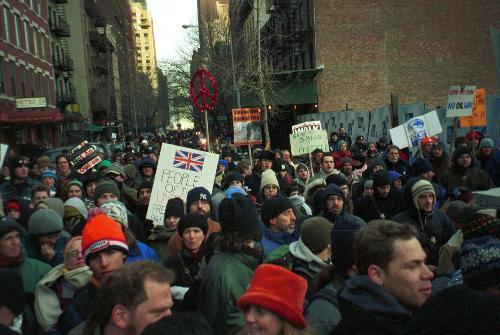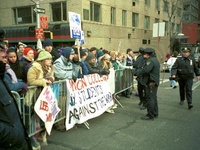
Protesters crowd a New York City street Saturday to demonstrate against a potential war in Iraq. Over 50 Harvard students participated in the rally, part of a day of anti-war protests around the world.
NEW YORK—More than 50 Harvard students braved the cold and a maze of police barricades this Saturday to join thousands in New York City protesting an impending war against Iraq.
The avenues of the city teemed with demonstrators as they wove their way to the main rally site near the United Nations, chanting and holding signs.
The New York rally—which drew around 100,000 people according to the New York Police Department and close to 500,000 according to the organizers of the protest—was part of a day of anti-war protests in over 15 countries called “The World Says No To War.”
Members of the Harvard Initiative for Peace and Justice (HIPJ) left for New York at 6 a.m. Saturday morning with homemade banners and equipped with emergency phone numbers in case they were arrested.
The students carried everything from a large sign that read “Harvard Students Want Peace” to a poster bearing photographs of Arab children and the words “Free Bodybag With Every Fill-Up!”
The system of police barricades—which forced some to march over 30 blocks to reach the rally site on First Avenue—created another issue for the crowds to protest.
Protesters said the crowd flow problem was exacerbated by a complex system of “holding pens” that prevented them from moving south on First Avenue.
Protesters walked up Second and Third Avenues to 70th Street where they were permitted to walk over to First Avenue and then down to the rally stage.
Throughout the streets, protesters chanted a battle cry of “Whose streets? Our streets!” at the police who manned the barricades.
HIPJ member Alyssa M. Shell ’05 said she decided to go to an unofficial rally in Times Square because she heard itwas impossible to reach the rally on First Avenue.
Matthew R. Skomarovsky ’03 said he spent an hour-and-a-half on Second Avenue just trying to figure out a way to get to the rally.
“People’s right to cross the street and just to freely assemble was systematically violated,” Skomarkovsky said. “It made me pretty frustrated and angry.”
One man, who said he was a veteran of the Vietnam War and the peace protests against it, led the chorus of shouts against the police on 53rd Street and First Avenue.
“This is insanity,” he said. “These fences are made for animals, not human beings.”
One female police officer said she recognized the crowd’s right to protest—but had to maintain order.
“This is freedom at work,” she said of the protests. “This is what it’s all about, there’s nothing wrong with that...We understand their position, they understand ours; we’re trying to work together.”
Upper East Side resident Cathy Kos said she was not participating in the protest, but thought the city had handled the crowd-control poorly.
“This better be a message to the city,” she said. “Because if there’s a war there are only going to be more rallies like this.”
Instead of following the designated path, many protesters formed miniature demonstrations of their own, with groups of several hundred marching up and down Second and Third Avenues.
At the rally site, famous peace advocates such as South African Anglican Arch-Bishop Desmond Tutu, actress Susan Sarandon and Martin Luther King III spoke out against the war.
Folk singers Pete Seeger and Harry Belafonte also performed for the crowd under a banner that read, “The world says no to war.”
Handheld radios broadcast the performance to the sea of people that stretched 20 blocks up First Avenue.
Other protesters danced and sang to the rhythmic pounding of bongo drums—and makeshift musical instruments—that some protesters played as they pressed forward towards the stage.
Thousands of police officers patrolled the city blocks in an effort to keep the protest under control.
The city stationed sharpshooters on building roofs around the U.N. and used bomb-sniffing dogs as a precaution against terrorism.
Security concerns were the grounds on which a federal court denied United for Peace and Justice—the umbrella group that planned the event—a permit to march on Saturday.
But despite the decision, protesters still marched near Times Square, continuing their chants.
The protest was mostly peaceful. The New York Police Department said they made 257 arrests.
HIPJ members said they thought the rally was a success despite what they described as an overbearing police presence.
“I was really impressed by the magnitude of the people who turned out and their persistence to rally despite the police presence and their ability to not get into conflict,” said Paul G. Dexter ’03, a member of HIPJ.
“As for Harvard, I would say it was definitely a success for the movement,” said Michael Fournier, an employee in the Registrar’s Office and one of the organizers of the trip. “We hope to continue our success into the future.”
Fournier said HIPJ—which was founded on September 11, 2001, to oppose a violent response from the U.S. government to the terrorist attack— is also planning a walk-out from classes if the U.S. goes to war against Iraq.
–Staff writer Nathaniel A. Smith can be reached at nsmith@fas.harvard.edu.
Read more in News
Black Female Alums Celebrate Third Decade













